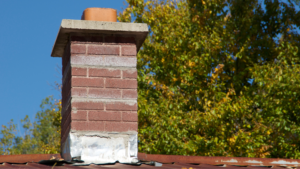
Water Damage
Nothing weakens bricks and mortar faster than moisture. It causes masonry to crumble. It encourages mold. Worst, in cold weather, it can freeze and expand, creating cracks that grow until they undermine the entire structure. Signs of water damage include:
- Shaling and Spalling. Bits of broken brick at the bottom of the chimney or on the ground outside are a clear sign that water has begun seeping into the masonry.
- Efflorescence. Efflorescence turns bricks white. It’s caused when water and salt mix together inside your masonry to create a crystalline substance. While it can be scrubbed away, you’ll need to hire a contractor to repair the underlying problem.
- Rusted Damper. Dampers are meant to control airflow in and out of your chimney. Rust on the damper can be difficult to spot, but if the damper is hard to close or fails to create an effective seal, it may be a sign water’s gotten into your chimney.
Cracks
While water damage can be prevented or halted by sealing or replacing your masonry, cracks are a sign it may be too late. Cracks can be caused by water damage, as well as earthquakes, shifting foundations, lightning strikes, improper construction, or mechanical damage from a ladder or antenna.
Cracks in the chimney crown are particularly bad. The crown prevents moisture from getting into the flue lining. If it’s cracked, serious water damage can occur. Installing a chimney cap is the simplest and cheapest way to protect the crown and prevent rain and snow from falling into your chimney.
Leaning Chimney
One of the obvious signs you need a new chimney. In most cases, partial or total rebuilding is the only solution. Call a contractor right away before your chimney falls over and damages your house or injures you and your family.
Cold Floors Around the Fireplace
Most modern fireplaces include a heat exchanger around the combustion chamber. When the fire is lit, heat from the combustion chamber is absorbed into the heat exchanger, which uses it to circulate warm air through the room. But if the exchanger is exposed to cold air, its temperature drops and the air sinks and escapes out the bottom of your fireplace rather than the top, creating cold floors.
There are several causes, including open dampers, poor insulation, and negative pressure in your ventilation system. If your brick and masonry has been damaged, your chimney may no longer be able to prevent cold air from getting in and interfering with the heat exchanger.
Keeping Your Home Warm with Agway
A fireplace and chimney are a great way to supplement your heating system. But while fires heat a single room, Agway’s energy and natural gas supply can help you heat your entire home. We also safeguard your heating system. Every customer who joins is automatically enrolled in our EnergyGuardTM program. If your furnace fails unexpectedly, you make one call to Agway. We schedule the repair and pay to replace all covered parts. There are no service fees or deductibles. Contact us today to learn more and become a member!